The Art of Glass Beads
The glass beads, small, precious and coloured, are artefacts of ancient origin. That in Venice gave birth to an art with unique characteristics, still practiced today by “perlere”, “perleri”, “grinders”. Who melt, blow , shape the coloured glass to obtain perforated spheres or cylinders. Skilled artisans then create necklaces, earrings, accessories. Thanks to which traditions, memory and skills are handed down. In Venice alone, estimations point that this art counts with more than 300 artisans. Authentic holders of the knowledge related to this particular art. Certainly, these are not simple objects: each pearl, unique in its creation, tells a story, a moment, a life experience of those who, with skill, created it.
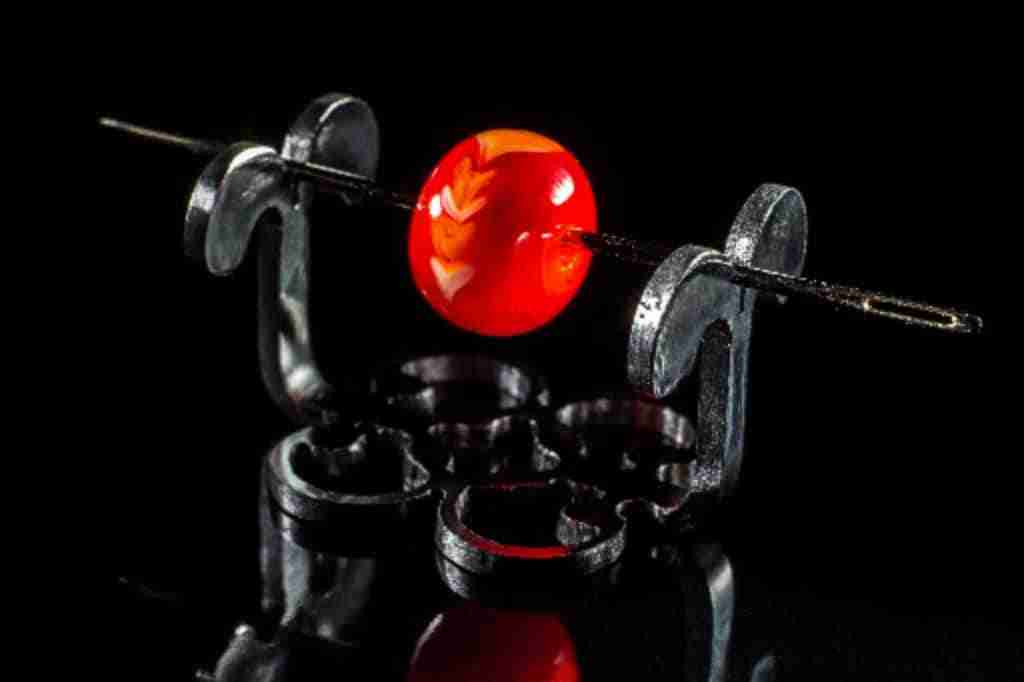
Two production centres have been particularly important in this art since the 16th century. Paris, with its community of glass bead specialists, and Venice, the true European capital of glass. Glass bead was produced in Murano and in all the Venetian territory.
History of art of glass beads in Venice
The art of glass beads is an ancient practice. Linked to the mastery of processing raw material thanks to the skilful use of fire. The creation of pearls dates back at least to Roman times. Although an older origin in Egypt or Mesopotamia is not excluded, but it is an activity that is particularly linked, in Italy, to the historic area of the city of Venice. And also the islands of Murano, Burano and Torcello. The production of glass beads in Venice dating back to the fourteenth century. Because it was a precious commodity for trade. It is interesting to remember that in 1291, a decree of the Venetian government ordered glass producers to move their work to the island of Murano. Above all, to avoid the great risk of fire in keeping the kilns in the historic centre.

Venetian production represents not only excellence. But a traditional knowledge handed down from generation to generation for over 700 years. The oldest Venetian document attests as early as 983 AD. a production of glass pastes in imitation of precious stones. The “verixelli”. While in 1338 the existence of glass rosary beads (“paternostri de vitro”), pearls created for religious purposes. And which, following exchanges commercial, assumed new monetary, symbolic, apotropaic meanings and functions.
“Veriselli” Beads
In the thirteenth century the first testimonies speak of a type of pearl called “veriselli”. That is glass imitations of precious stones. Created for trade after the Venetians had sniffed the deal from a story by Marco Polo. That told of love for the Asian populations for precious stones. In addition to the “veriselli”, the artisans also created the “paternostri”, the pearls of the Rosary. Bought by Christian pilgrims visiting Venice. During the Renaissance, rosary manufacturers and merchants made glass beads for rosaries but also for ornaments (necklaces, earrings, buttons).
The sartorial fashion of the time characterizes itself by sewing or weaving pearls to embellish dresses. Which adorned shirts, coats, hats, gloves, boots and belts. Glassmakers try to imitate precious and semiprecious stones, mainly crystal and turquoise. Glass ornaments enjoyed the same prestige as the precious stones they imitated.
“Margarita” Beads
Then came the time for a smaller type of glass bead, the “margarita”, which used thin perforated glass rods. Compared to “paternostri”, “margarites” allowed mass production much faster. And also at lower costs. In the 19th century, “margarites” began to be called, as they do today, “conterie”. Strung in bunches by “impiraresse”. From the Venetian verb ‘impirar’, meaning to insert.
Still today their task is to pour the beads divided by colour, into a wooden tray with a curved bottom. Holding 40-80 very thin, fan-shaped needles in their hands. With which to thread the beads into long cotton threads or linen. In the past this was a role only for the female gender, played mainly from home.
 Photo by le2960 via Pixabay
Photo by le2960 via Pixabay
The “impiraresse” were paid by the piece without having direct contact with the Murano glass factories. In fact, they relied on intermediaries who managed their payments. At the fall of the Republic of Venice the production of pearls was the only one to resist the crisis. It saved the Venetian glass industry, with continuous growth until 1900.
History of art of glass beads in France
In France, since the late Middle Ages, craftsmen learned the secrets of the trade from Venetian glassmakers. Making the glass tradition their own. To the point that the city of Nevers became a small French Murano in the seventeenth century. At the beginning of the modern era, also a particular type of pearl was invented in France: the false pearl. Which simulated the real pearl, the one secreted by the oyster. In 1686 the French Jacquin invented in fact a mother-of-pearl paste. Called essence of the East, injected into a blown glass sphere filled with wax.
In the 18th century, men blew pearls from Nevers glass tubes and women filled them with oriental essences. Over the next century, the profession became more feminine, producing around 300 glass beads per day. Workshops were mainly in Paris, but widespread throughout France. The demand for these pearls grew steadily and with it the production, until the 19th century.
Chevron beads used as trade beads
 Photo by ZSM, CC BY-SA 3.0, via Wikimedia Commons
Photo by ZSM, CC BY-SA 3.0, via Wikimedia Commons
The golden period for the production of glass beads goes from the mid-nineteenth century to about 1920. At that time, from the skill and experience of Venetian artisans, productions of great beauty were born. Destined to become very famous in the world of collecting and antiques. After the First World War, with the progressive dissolution of colonialism. The exchange pearls, replaced by money, lost their original function. Becoming more and more objects of art, jewels and personal ornaments. While the processing techniques were made in this sense gradually more refined, to create valuable artefacts. Sometimes small glass masterpieces, known all over the world.
Over the centuries, from generation to generation, up to the present day. This art, felt by the inhabitants of the area as a shared identity and cultural value, has been enriched. With knowledge, inventions and technical innovations. Has promoted intercultural dialogue, has contributed to increasing creativity. And has also favoured the dynamics of social interaction.
Glass Blowers of Murano – Oil Painting
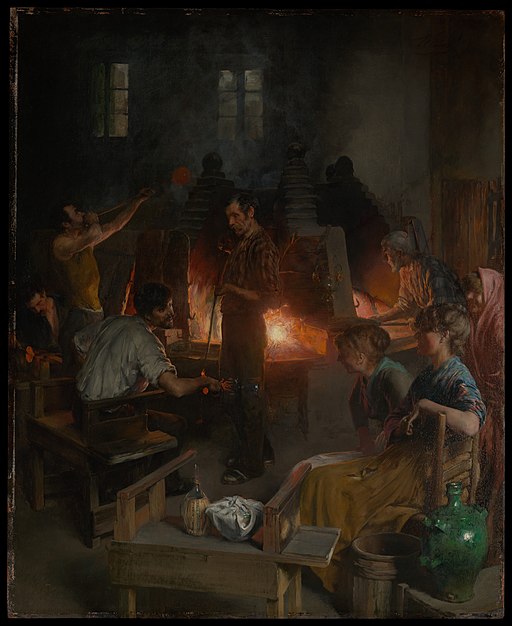 Charles Frederic Ulrich, CC0, via Wikimedia Commons
Charles Frederic Ulrich, CC0, via Wikimedia Commons
This particular manufacturing tradition represents an intangible heritage of considerable significance and importance. For centuries, in fact, since the late Middle Ages. Venice was the seat of a process that had immense success all over the world. That of glass beads, traditional craftsmanship handed down from generation to generation, without interruption, for over seven hundred years. Huge quantities of pearls were produced in the lagoon city. Where the companies that perpetuated this art were located. And from here also they crossed the oceans and travelled the continents. Used as a bargaining chip, instead of money, to buy even precious materials, such as gold, ivory, furs. And other exotic luxury goods.
Art of glass beads today
Today the “perlai” (the craftsmen of glass beads) make the pearl and can specialize in one or more techniques. The “molatore”, on the other hand, models the pearls from perforated glass reed using a water wheel. Evaluating how incisive the abrasion of the glass must be to bring out the decorative motifs without damaging the pearl. The “impiraressa”, generally a woman, inserts the beads through precise movements and creates various artefacts with them. Finally, the Master Glassmaker. Who in the furnace intervenes, together with the helpers, only in the realization of the perforated and hand-pulled rod and of the non-perforated glass rods.
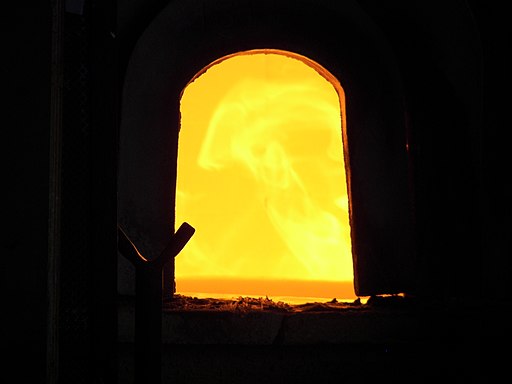 Photo by Wknight94, CC BY-SA 3.0, via Wikimedia Commons
Photo by Wknight94, CC BY-SA 3.0, via Wikimedia Commons
The glass beads, fragile, coloured. With multiple designs and shapes. Sold in the windows of shops and laboratories, are one of the peculiarities that make Venice unique. And leave also an indelible memory in the visitor. One can also find its traces in dedicated places. Such as Calle delle Conterie, or discover its secrets in workshops which – upon reservation – open their doors to visitors. The Venetian “sestiere” (the district) historically linked to the threaders of pearls, still well rooted in the collective memory of the city, is Castello.
Venice, sestiere du Castello and Murano island
 Photo by Jean-Pol GRANDMONT, CC BY 4.0, via Wikimedia Commons
Photo by Jean-Pol GRANDMONT, CC BY 4.0, via Wikimedia Commons
The production of glass beads is an ancient know-how. In the last twenty years it has experienced a new boom. Marked by a return to the roots of the profession and an opening to different forms of artistic expression. The manufacture of glass beads borrows from all the techniques known since ancient times: Phoenician, Egyptian, Roman, Venetian and Bohemian. These techniques are taken up, mixed and modified. With the aim of reinventing a personal creative language. Current artistic trends also influence the production of glass beads. The art of the glass bead thus makes techniques, ancient or contemporary, coexist. Where creativity offers the pearl the means to develop its own cultural identity, differentiating itself from stereotyped productions.
 Photo by Wolfram Linden from Pixabay
Photo by Wolfram Linden from Pixabay
Learning and the transmission of know-how takes place mainly in family workshops and companies. Individual “expert” pearl producers are happy to pass on their knowledge to people who want to learn. Because their motivation is very high. The transmission of more complex techniques. Or improvement, takes place after a few months or years of training in basic techniques with pearl experts. Including foreign ones. More immersive relationships, demonstrations organized during exhibitions. Or laboratory visits, are also means of transmitting know-how. Allowing you to meet artisans who try their hand at this art of fire.
The art of glass beads widespread. Not only in Venice. But also in France. Links closely to the wealth of knowledge and the mastery of a material, glass. And of an element, fire. It brings together shared knowledge and techniques, refers to particular artisan procedures and tools. And includes also different processing phases.
Art of glass beads as Intangible Cultural Heritage
The art of glass beads is part of the List of Intangible Cultural Heritage since 2020. In a transnational candidacy that has seen Italy alongside France. A a Country in which the radiating pole of the art of glass beads it’s Paris. The Italian and French communities have been united since the 19th century by numerous technical, cultural and artistic exchanges. It is not the pearls themselves that receive UNESCO recognition, but the entire supply chain that leads to their production. There are different processes:
- “Lume” pearls (wrapping melted glass on a flame around a metal stick),
- “Rods” pearls (cutting and grinding of perforated glass rods),
- threading of the “conterie” (tiny beads of glass), and
- production of glass rods in a furnace.
The “Comitato per la Salvaguardia dell’Arte delle Perle di Vetro Veneziane” (Committee for the Safeguarding of the Art of Venetian Glass Beads) was founded in Venice in recent years. And brings together the artisans of this ancient art. Also in France, several hundred glass bead producers have gathered in the “Association des Perliers d’Art de France“. And practice this ancient knowledge in their individual workshops. The majority is made up of pearl producers, aged 40 to 60, partly professionals. Who work mainly alone and without employees.
Using Flame
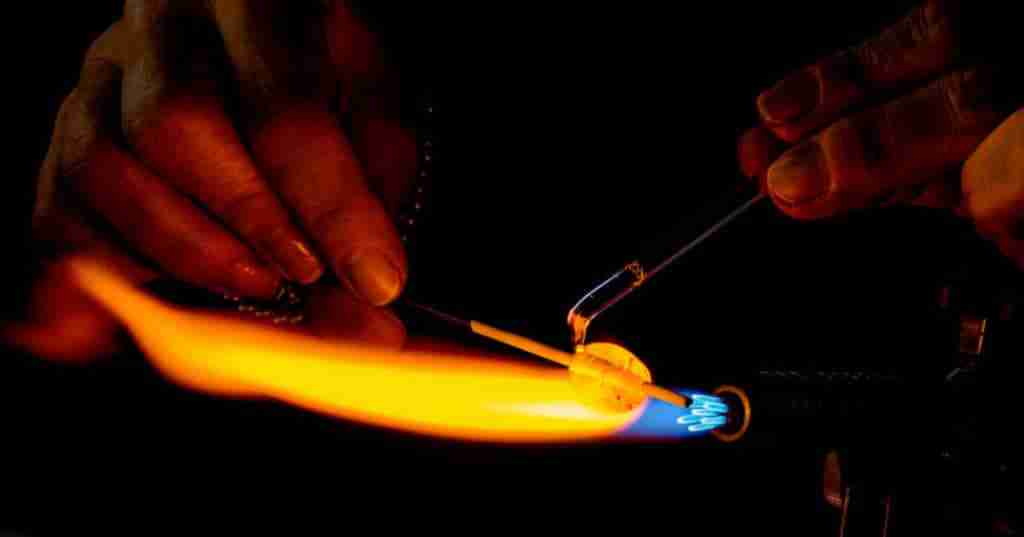
Flame spun glass techniques remain traditional. Molten glass is wrapped around a steel mandrel before being decorated. Day after day these craftsmen work on the development of these techniques and their creative expression. On the transmission of their know-how and on the promotion of this complex and fascinating profession. The basic techniques are few, but their combination and level of mastery open up infinite universes of artistic creation. Technical demonstrations and glass bead exhibitions take place all over France. In addition to the permanent exhibitions in renowned museums. The exhibitions offered by the community of enthusiasts mainly attract pearl producers for a day or a weekend to meet, live their common passion. But also exchange experiences with each other and with crafts enthusiasts.
French glassmakers are therefore federated into the Association des Perliers d’Art de France. Which represents the profession. And its various sectors, promoting interactions and facilitating meetings, exchanges and sharing of information. In a climate of mutual personal and professional enrichment. The other objectives of the Association are to promote glass processing and its fields of activity. By safeguarding, enhancing and developing manual skills and technologies. And also to defend the interests of French glassmakers, representing them in public or private administrations.
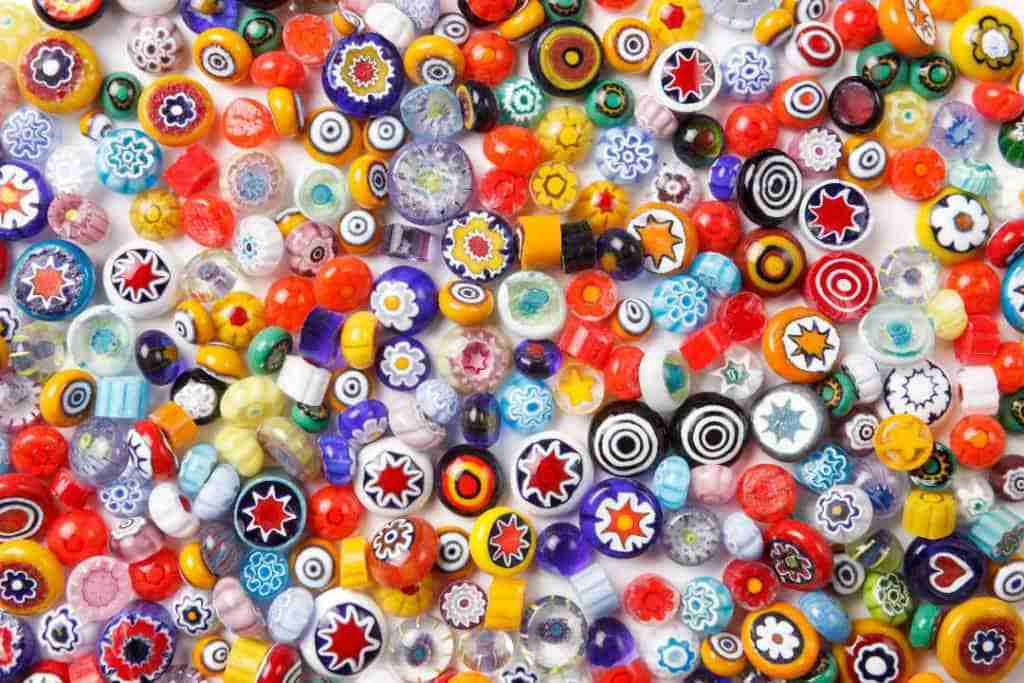
Shared Passion
This shared passion then binds pearl producers to each other, regardless of their level of craftsmanship or other personal considerations. Exercising the same gestures, sharing a common vocabulary and perpetuating this ancient technique unites glass bead manufacturers. Every meeting during exhibitions or events highlight this bond . And in particular during the Sars-Poteries biennial. Where a multitude of pearl producers from all over France gather around their common passion.
Creativity supports the creation of “art pearls”. That is to say rare or even unique objects which illustrate the personal artistic expression of the pearl. And result from the infinite combination of a large number of techniques of a wide range of colours. Like the painter or sculptor, the pearl artist testifies. Through his production, to the richness of his artistic universe and his ability. Through his know-how, to appropriate the material to make it a unique object. The pearls of art fascinate and tell of the encounter between glass and fire; they convey stories, atmospheres and represent the freedom to invent. The glass bead craftsman creates a miniature, imaginary and unique world.
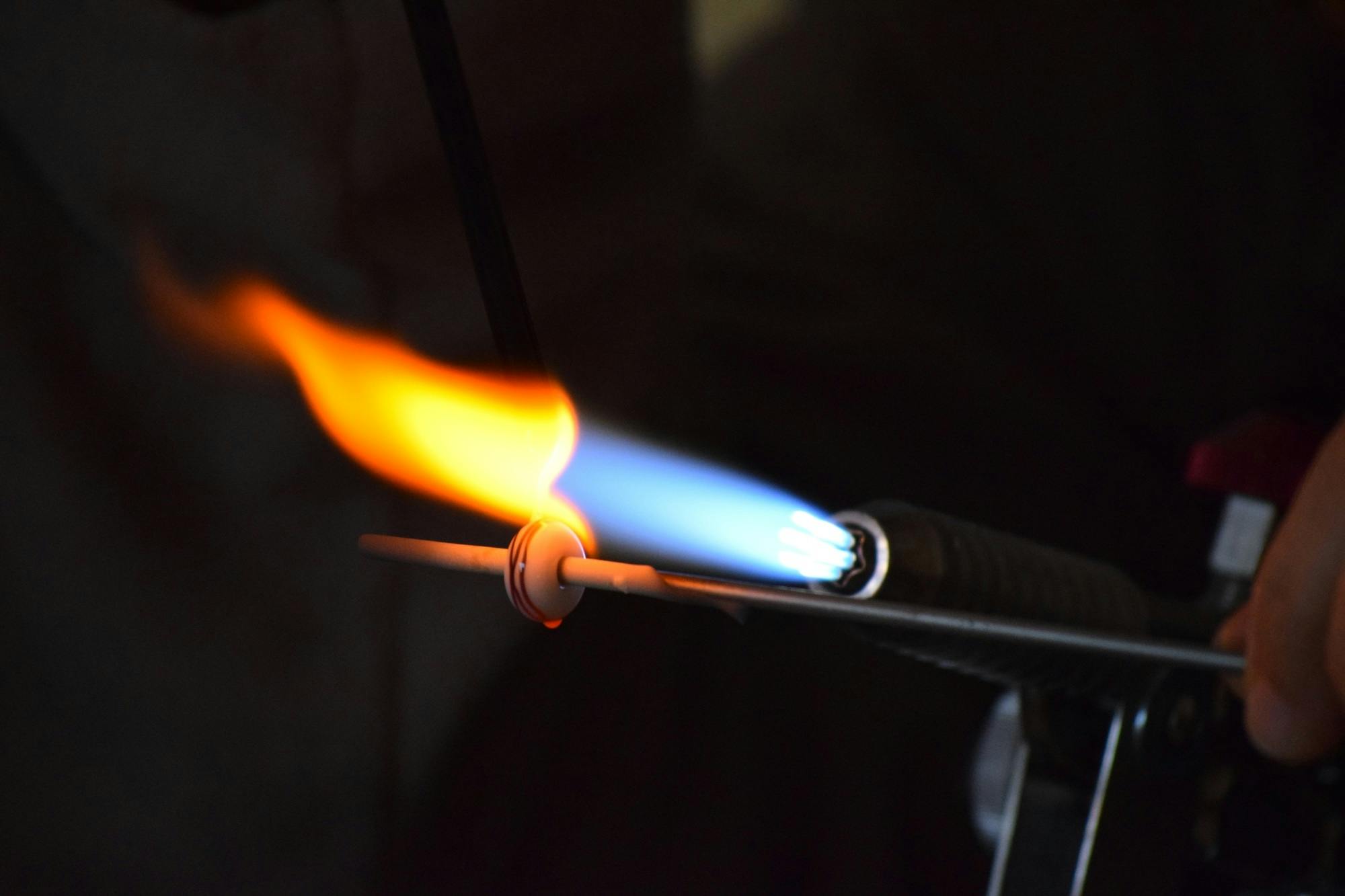
The production of glass beads takes place in several individual workshops. Where the craftsman usually seats behind a blowtorch. Fixed on a table in front of him. But can choose to work standing up. This flame is powered by gas. Usually propane (but you can also use butane or natural gas) and oxygen. The flame processing time required to make a glass bead can range from a few seconds to several hours on a single bead. The dimensions of the glass beads thus produced can vary. From a few millimetres in diameter to about ten centimetres in length. The most common dimensions for glass beads intended to be worn.
How to make glass beads
But what kind of glass is used to make pearls? The standard diameters of the glass rods used vary from 5/6 mm to 10/12 mm. Most pearl manufacturers use soda-based glass. In Venice, makers use glass produced in Murano. In France, however, the main glass used is from Venice. From the island of Murano. But also glass from the United States and China are compatible with Italian glass. And can therefore be used together on the same pearl. Also used glass produced in Germany and the Czech Republic, of the soda-lime type.

To make the pearl we start with a glass rod. The artist wrap the molten glass, which has become pasty, around a metal mandrel. Previously immersed in a separator to prevent the hot glass from sticking to the metal. The mandrels are mainly stainless steel rods, of different diameters. Which determine the size of the pearl duct, from 1.6 to 5 mm. The mandrels are pre-immersed in a kaolin-based liquid separator. Which allows the hot glass not to stick to the metal. After the pearl has cooled. The mandrel is placed in the water. Which partially dissolves the separator and also facilitates the removal of the pearl. The inside of the pearl is then cleaned. To remove the excess separator that comes in the form of a powder when dry.
By rotation and gravity, the hot glass bead naturally takes a round shape. The shape of the pearl can be round, tubular, conical or biconical, flattened, square, rectangular or random in shape. Forming the shape of the pearl. Either by simple rotation and controlling the gravity of the molten glass, or by changes made using small metal or graphite tools (moulds, pliers, tips, …).
Using Moulds

The hollow glass beads can instead be made using the metal mandrel as a support. To do this, the craftsman creates two glass discs separated by a space. He mounts these discs to the desired height, then merges them together. The hot air thus trapped in the pearl, by expansion, pushes the walls of the pearl from the inside. Helping to form the hollow pearl. This pearl can then be decorated and shaped if desired.
Another technique is that of the blown glass bead. Which uses gestures similar to those used by the glass blower with the rod. The glass is melted with the flame. And placed at the end of an empty rod. Into which the craftsman blows an air bubble. A first hole is made at the end of this bubble, then the pearl is detached from the rod, creating a second opening near the rod. And after polished with the flame.
Blowing Glass
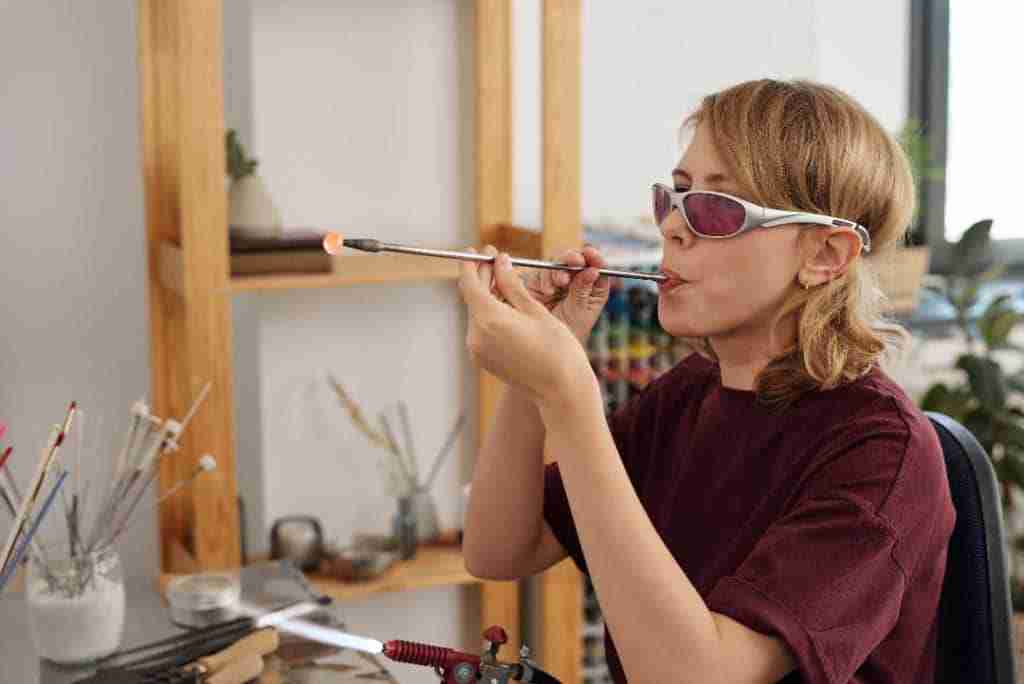
Once formed, the base glass bead can be flame decorated by adding glass points of other colours, previously prepared glass threads, glass powders or enamels, leaves or threads of gold, silver, copper, bronze, etc. .. Throughout the manufacturing process, the pearl must kept an high temperature. So that it does not suffer thermal shock and does not break. The pearl construction must respect meticulously its phases. Where heat control and permanent rotation of both the pearl and the molten glass are essential.
Glass Bead Decoration
The decoration of the glass bead is based on some main techniques. Which allow the pearl to have infinite aesthetic variations, more or less complex:
– The thread pulling consists in pulling glass threads of thin diameter. Applying thin lines or motifs and finer points to the pearl.
– Twisting consists of pulling the threads containing different colours, twisting them. These threads allow you to apply stitches or strokes of mixed colours.
– The deformation of the decorations. By heating the pearl in a localized way. It is possible, by pulling it with a metal tip or a glass thread. Or by rotating it, to deform the decoration in advance. The round points can thus be deformed to make hearts, stars, drops… Using the shade technique, creates distorted lines.
– The inclusion of bubbles. A depression is made in the pearl using a metal tip, then it is covered with transparent glass. Which has the effect of trapping a small air bubble in the depression.
– The processing of the “murrine” is a more complex work. Based on multi-coloured glass rods, which allow you to create simple circular or square motifs or more complex designs. Revealed when this rod is cut into thin slices. The murrina is designed by assembling different colours of glass around a core. Then heated and elongated in the shape of a rod. Some phases of the making of murrine can use moulds of various shapes. Often in bronze.
Murrine
 Photo by Davidpatchen, CC BY-SA 3.0, via Wikimedia Commons
Photo by Davidpatchen, CC BY-SA 3.0, via Wikimedia Commons
– Coating consists of coating the base pearl with a layer of clear, colourless or tinted glass. Its function can be to give depth to the design of the underlying pearl. Or to deform the design attached to the base pearl.
– The metallic inclusion. Leaves or threads of gold, silver, copper, bronze, etc… Can be hot embedded in the pearl.
– Enameling through the use of glass powders or larger glass grains, applied hot on the pearl.
Creating resistance
Whatever the technique used, once the work with the flame is finished, the pearl is placed in an electric annealing oven. Annealing is slow, controlled cooling that allows the glass to cool evenly across the thickness of the pearl. Annealing is necessary to make the pearl more resistant and solid. The annealing cycle of a batch of glass beads can take up to six hours before returning to room temperature. Once cooled, the glass bead can still suffer transformations. And processed using a multitude of cold working techniques. Such as sandblasting (sending high pressure sand onto the pearl), acid etching, diamond-tipped etching, polishing, etc…
The range of shapes, colours and finishes available to the pearl is multiple and very rich. It opens up endless possibilities in terms of creativity and aesthetics. And allows the pearl maker to concentrate in a relatively small space a unique know-how. That accumulates in the hours of practice spent behind the flame. The gesture becomes more precise over the years of practice. The hand can “learn” the gesture only thanks to the hours dedicated to the practice. However, even though one well master these gestures. Allowing to reproduce pearls in multiple copies. Pearls are never the same and each is unique. Since the origins of humanity, the glass bead has been charged with a personal symbolism, but also with a social one due to the way it is given, transmitted from generation to generation, often marking important moments in life.
Safeguarding this ancient art
But why are glass beads so important? Venetian production dates back to the fourteenth century. And small objects soon became a precious exchange and export commodity to Africa, the Americas and India. But there are other aspects to take into account. Their processing link closely to the wealth of knowledge and the mastery of a material – glass – and of an element, fire. Perhaps for this reason, and for the light they emit, pearls seem to contain an almost magical power.
The art of glass beads would not be possible without shared knowledge and techniques. Without tools and procedures that allow you to create various types of artefacts. Such as the tiny “beads” obtained from thin perforated glass rods and often used for sumptuous embroidery; they are now a rarity, as they are no longer produced. And then those “a lume”, documented since the seventeenth century, obtained by wrapping molten glass on a metal stick. Creating infinite variations of effects and colour. Finally, the “rod” beads, obtained by cutting and grinding perforated glass rods. Murrine also belong to this category.
Hence the need to create a Committee for the Safeguarding of the Art of Venetian Glass Pearls. In order to promote the initiative to start a candidacy process for the Representative List. Established by the Unesco Convention for the Protection of Intangible Cultural Heritage. Objective achieved, with the participation of the Association des Perliers d’art de France, in 2020.
Intangible Cultural Heritage of Humanity
The art of the glass bead has been declared an Intangible Cultural Heritage of Humanity. Not the object itself, the glass bead, but the know-how and therefore the art. This is a very important difference. We speak of a set of inseparable aspects: representations, practices, knowledge, techniques, tools, skills, knowledge, values, memories, skills, sensitivity. With the art of the glass bead, we focus on creative processes. And not on products. On the transmission of knowledge. On the importance of increasing awareness of its value among the younger generations. And the sense of belonging to a particular community.

The art of glass beads is a cultural heritage passed down from generation to generation. It is a living heritage that communities, in response to the environment and interaction with nature and history, continuously recreate. The ancient practice is an example of how ingenuity leads to finding innovative solutions. Promotes respect for cultural diversity, human creativity. And fosters lasting development through the reuse of many materials. Including flawed pearls, ancient stones, fragments of glassy reeds. The recognition of UNESCO is therefore precious for the safeguarding of this art. And the future goal of both the Venetian and French committees is the multiplication of initiatives. Carried out at local, national and international scope.
Through the glass beads, their infinite beauty inextricably linked to their extreme fragility, we want to remind the whole world of the duty to protect the fruit of man’s ingenuity and creativity. Only in this way can this noble art be handed over to future generations.
Resume
The ancient art of the glass bead, that is the technique that shapes glass with fire. And transforms it into a perfect microcosm of colours, is part of the Unesco list of Intangible Cultural Heritage since 2020. An important recognition that allows to safeguard an ancient know-how. A practice based on the wealth of knowledge and skills transmitted from one generation to the next. One can find the holders of this ancient art in Venice and France. France is a Country where there is a widespread artisan tradition. That is in many respects close and similar to the Venetian one, born thanks to the export of craftsmanship developed in the Venetian Lagoon.
Unesco wanted to give relevance to all the work behind the art of glass beads. A living heritage, which sees tradition innovate and transform this art. A new record that confirms the richness of the widespread cultural heritage. And that rewards the commitment of the communities in enhancing the set of knowledge and traditions that distinguish them. But also a recognition to the master craftsmen. Who pass on the knowledge of one of the most ancient arts to future generations.
